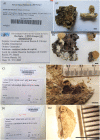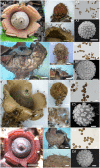Hidden fungal diversity from the Neotropics: Geastrum hirsutum, G. schweinitzii (Basidiomycota, Geastrales) and their allies
- PMID: 30726262
- PMCID: PMC6364924
- DOI: 10.1371/journal.pone.0211388
Hidden fungal diversity from the Neotropics: Geastrum hirsutum, G. schweinitzii (Basidiomycota, Geastrales) and their allies
Abstract
Taxonomy of Geastrum species in the neotropics has been subject to divergent opinions among specialists. In our study, type collections were reassessed and compared with recent collections in order to delimit species in Geastrum, sect. Myceliostroma, subsect. Epigaea. A thorough review of morphologic features combined with barcode and phylogenetic analyses (ITS and LSU nrDNA) revealed six new species (G. neoamericanum, G. rubellum, G. brunneocapillatum, G. baculicrystallum, G. rubropusillum and G. courtecuissei). In additon, the presence of hairs on the exoperidium, a commonly used feature to diagnose Geastrum species, proved to be ineffective because it is a derived character within subsect. Epigaea.
Conflict of interest statement
The authors have declared that no competing interests exist.
Figures





References
-
- Morawetz W, Raedig R. Angiosperm Biodiversity, Endemism and Conservation in the Neotropics. Taxon. 2007; 56(4): 1245–1254. 10.2307/25065916 - DOI
-
- Morrone JJ. Biogeografía de América Latina y el Caribe. M&T—Manuales y Tesis SEA, vol. 3 Zaragoza: 2001. 148 pp.
-
- Sodhi NS, Ehrlich PR. 2010. Conservation biology for all. Oxford University Press, Oxford, UK: 344 p.
Publication types
MeSH terms
Substances
LinkOut - more resources
Full Text Sources

